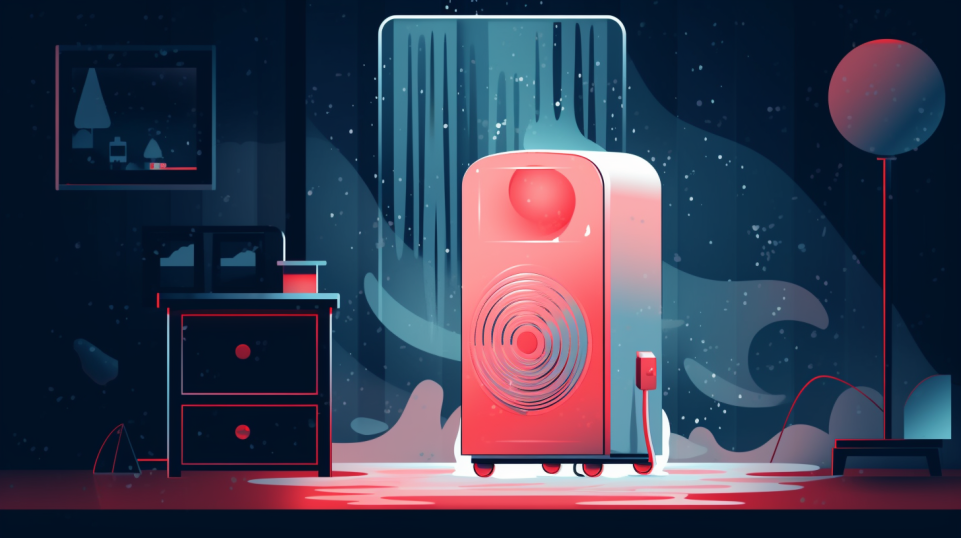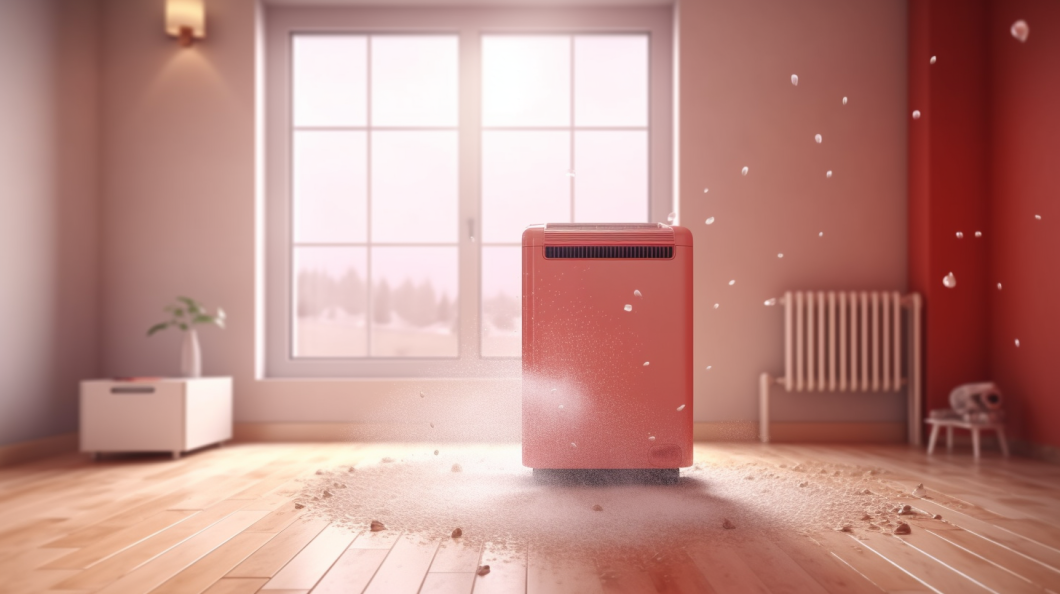Indoor air quality is a fundamental aspect of maintaining a healthy and comfortable living environment. One device that plays a pivotal role in this is the dehumidifier. By controlling humidity levels, it not only ensures a comfortable ambiance but also aids in preventing health problems caused by mold, mildew, and excessive dampness. However, like any mechanical device, dehumidifiers are prone to certain issues, and one of the problems you might face is your dehumidifier icing up.
This may seem peculiar. After all, a dehumidifier’s main role is to remove moisture from the air, not to produce ice! Yet, it’s a common issue that many homeowners face, causing the device to malfunction or even stop working altogether. In this blog post, we will delve into this frosty issue, understanding why your dehumidifier might be turning into an unintended ice maker and how you can address and prevent it from happening. So, let’s defrost this problem and restore your dehumidifier to its optimal functioning.
Understanding Dehumidifiers
Before we dive into the main issue at hand, it’s crucial to grasp how a dehumidifier operates. Essentially, a dehumidifier is a device that regulates the amount of moisture in the air within enclosed spaces like homes or offices. It functions quite similarly to a refrigerator or an air conditioner.
A dehumidifier contains several key components, including a fan, cooling coils (or evaporator), a reheater, and a reservoir. Here’s a simplified process of how it works:
- The fan draws in air from the room.
- This air passes over the cooling coils, where moisture in the air condenses into water droplets.
- The droplets collect into the dehumidifier’s reservoir.
- The air, now dehumidified, is reheated and released back into the room.
This cycle continues until the humidity in the room reaches the desired level set on the dehumidifier. However, when the dehumidifier starts to ice up, this cycle gets disrupted. This happens when frost starts forming on the cooling coils, impairing the appliance’s ability to pull moisture from the air efficiently.
Now that we’ve understood the basic operation of a dehumidifier let’s delve into the reasons behind why it might start to resemble a mini glacier in your living room.
Common Reasons Why a Dehumidifier Ices Up
When you see your dehumidifier icing up, it’s natural to feel confused. Why would a device designed to reduce moisture start to freeze? The answer often lies in one or a combination of the following factors:
1. Inadequate Room Temperature
Dehumidifiers work best in environments where the temperature is above 60 degrees Fahrenheit (about 16 degrees Celsius). If the room temperature falls below this, the moisture condensing on the cooling coils can freeze, leading to ice build-up.
2. Low Refrigerant Levels
The refrigerant in the dehumidifier is what cools the coils, causing moisture to condense. If your unit is low on refrigerant, the coils can become too cold, leading to freezing.
3. Dirty Coils
Dust and grime can accumulate on the coils over time, impeding the unit’s airflow and causing the coils to become excessively cold. This, in turn, can lead to ice formation.
4. Faulty Fans or Motors
The fan in your dehumidifier plays a crucial role in circulating air over the coils. If the fan isn’t functioning correctly, or if the motor powering the fan is faulty, less air circulates over the coils. This decreased airflow can result in the coils getting too cold, leading to freezing.
Understanding these reasons is key to diagnosing why your dehumidifier is icing up. Next, let’s look at the signs that indicate your dehumidifier is freezing and the solutions to address this issue.
Identifying Signs of a Freezing Dehumidifier
Before your dehumidifier turns into an icy sculpture, it usually exhibits some signs that hint at the problem. Here are some telltale indicators:
1. Signs of Frost Build-Up: One of the most apparent signs is visible frost or ice on the dehumidifier, particularly on the evaporator coils. This is an immediate indication that your dehumidifier is freezing.
2. Performance Issues: If your dehumidifier isn’t collecting as much water as usual or if the air in your home feels more humid than normal, these could be signs that the device is not functioning properly due to icing.
3. Unusual Sounds: If you hear a humming sound but the fan isn’t blowing, or if there are any other unusual noises, this could mean that the dehumidifier’s motor is struggling against ice build-up.
Now that we’ve identified potential signs of a freezing dehumidifier, let’s move on to discuss how you can address this problem and get your dehumidifier back to running efficiently.
How to Fix an Icing Dehumidifier

If your dehumidifier has turned into an unexpected icicle, don’t panic. There are several steps you can take to restore it to its normal state.
1. Adjusting Room Temperature
If the room temperature is too low, try increasing it above 60 degrees Fahrenheit. This might be challenging during colder seasons, but using heaters or relocating the dehumidifier to a warmer part of the house might help.
2. Cleaning Coils
First, unplug your dehumidifier for safety. Then, remove the outer casing to reveal the coils. Using a soft brush, gently clean off any dust or grime from the coils. You can also use a can of compressed air to blow off any remaining dust. Make sure to follow your device’s manual for specific instructions and warnings.
3. Checking and Replacing Fans or Motors
If you suspect that the fan or motor is the issue, it’s best to consult with a professional unless you’re experienced in appliance repair. These parts can be complex and potentially dangerous to repair or replace without proper training.
4. Calling a Professional
If you’ve tried the above steps and your dehumidifier is still icing up, or if you’re uncomfortable performing these tasks yourself, it might be time to call a professional. An expert can correctly diagnose and fix the problem, saving you from potential stress and hassle.
Remember, safety should always be your first priority. If you’re unsure at any point, it’s always better to consult with a professional.
Once you’ve addressed the immediate problem, the next step is to take measures to prevent your dehumidifier from freezing up
Preventive Measures to Avoid Dehumidifier Freezing
Prevention is often better than cure, and this adage holds true for dehumidifier maintenance as well. By adopting some preventive measures, you can avert the problem of your dehumidifier icing up, prolonging its lifespan, and ensuring optimal operation. Here are a few tips:
1. Regular Maintenance
Keep your dehumidifier in good shape by cleaning it regularly, including the coils and the air filter. This will improve air circulation and efficiency, reducing the chances of ice build-up.
2. Proper Placement
Where you place your dehumidifier can impact its performance. Ensure it’s positioned in an area where there’s adequate air circulation. Also, avoid placing it against walls or furniture, which can obstruct airflow.
3. Appropriate Model Selection
If you live in a colder region, consider purchasing a dehumidifier designed for low temperatures. These models are equipped with features to prevent freezing, such as automatic defrost.
4. Monitoring Room Temperature
Keep a close eye on the temperature of the room where the dehumidifier is operating. If it regularly falls below 60 degrees Fahrenheit, you might need to adjust your home’s heating or move the dehumidifier to a warmer spot.
By adopting these preventive strategies, you can keep your dehumidifier running efficiently and freeze-free, contributing to a comfortable and healthy home environment.
Next, we’ll wrap up this discussion by summarizing the main points covered in this blog.
Conclusion
A dehumidifier is an invaluable device in maintaining the comfort and healthiness of your indoor environment. However, like any mechanical appliance, it can face certain issues, one of which is the surprising sight of your dehumidifier icing up. This problem, while common, can significantly hinder the device’s ability to perform its job.
We’ve discussed that this issue can stem from various factors like inadequate room temperature, low refrigerant levels, dirty coils, or faulty fans or motors. It’s crucial to be aware of the signs that your dehumidifier is icing up, such as visible frost, performance issues, or unusual sounds.
To address this problem, we explored solutions like adjusting the room temperature, cleaning the coils, checking the fans or motors, or consulting a professional when necessary. Equally important are preventive measures, including regular maintenance, proper placement, choosing the right dehumidifier model, and keeping an eye on room temperature.
By keeping these points in mind, you can ensure that your dehumidifier stays frost-free and operates at its optimal efficiency, contributing to a comfortable, healthy living environment.
FAQs about Dehumidifier Icing Up
Q1: Why is my dehumidifier not defrosting?
A: If your dehumidifier has an auto-defrost feature but is still icing up, it could be due to a faulty defrost thermostat or sensor. It could also be because the room temperature is consistently too low for the dehumidifier to handle.
Q2: Can I use my dehumidifier in the winter when it’s cold?
A: Yes, you can use a dehumidifier during winter, but the cold temperatures might lead to the unit icing up. If you live in a region with cold winters, consider purchasing a dehumidifier designed to operate in low temperatures.
Q3: What can happen if I don’t address the issue of my dehumidifier icing up?
A: Ignoring the problem can lead to the dehumidifier working less efficiently or not working at all. Over time, it can cause permanent damage to the unit. It’s better to address the issue as soon as it’s noticed to prevent any serious damage.
Q4: Can I manually defrost my dehumidifier?
A: Yes, if your dehumidifier is iced up, you can unplug it and let it sit in a warm room to allow the ice to melt. Be sure to place towels or absorbent materials around the unit to catch any meltwater.
Q5: How often should I clean the coils of my dehumidifier?
A: It’s recommended to clean the coils at least once a year. However, if your dehumidifier is located in a dusty environment or is used heavily, you may need to clean it more often.
Q6: How do I know if the refrigerant level in my dehumidifier is low?
A: Signs of low refrigerant might include less water collected in the tank, poor performance, and ice build-up on the coils. However, assessing refrigerant levels and refilling them are not typically DIY tasks. If you suspect this is the issue, it’s best to contact a professional.






